Panasonic Lumix GF3 Review
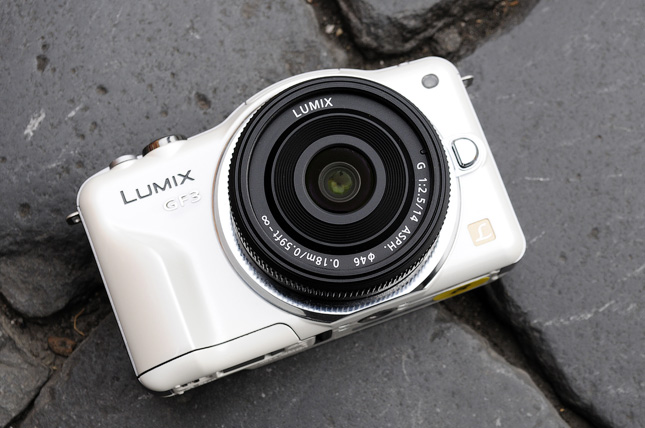
The confrontation of the manufacturers of system cameras (or, more simply, mirrorless) with each new announcement is gaining momentum. And if Olympus and Samsung in this marketing war look more like catching up, then Sony and Panasonic are proudly striding ahead. It is also interesting that while Sony announced the APS-C mirrorless NEX C3, Panasonic made its presentation with the Coliseum and Italian wine. Climbing the ramp into the Moscow-Rome plane, European and Russian journalists could only guess at what they would be shown. Everyone thought that a large-scale test drive of the previously announced G3 was planned, but the Japanese were all surprised. In the capital of Italy, in the strictest secrecy, we were shown a new model from the latest Panasonic mirrorless line - Lumix GF3, and with it a new lens for the Micro Four Thirds system - Leica GD Summilux 25mm / 1.4.
')
GF3
Looking at the Panasonic GF3, hardly anyone dares to blame the mirrorless ones that they are not small enough. If we compare the dimensions of this camera with the dimensions of the TZ20, the top ultrazoom from the same Panasonic, then we will see the following picture: 107.5 x 67.1 x 32 mm for GF3 and 104.9 x 57.6 for 33.4 mm for TZ20. It is not known whether developers have resorted to the help of nanotechnology, but it is difficult for me to present a more compact and convenient case. Looking at the semicircular protrusion on the top of the camera, you realize that they tried to reduce it to the maximum. In height, for example, there is no place less - the bayonet diameter does not allow (by the way, it has already decreased by 2.5 mm in height and 3.6 mm in width). For the sake of compactness, the developers even decided to abandon the hot shoe for accessories. But the flash, fortunately, remained. It is hidden just in this semicircular ledge.

The front and rear panels of the camera are made of metal; only the frame and the cover of the battery compartment around the case are made of plastic. In front there is a small protrusion under the middle finger of the right hand - for a more secure fit. Behind is a thumb rest, designed for the same purpose.
Controls on the body of the GF3 at least, the emphasis placed on sensory. But Panasonic, as always, offers a reasonable compromise and is in no hurry to give up mechanical controls. On the top panel there is an on / off switch, a shutter release button, a button for instantly starting video recording and a button that switches the camera to “intelligent auto mode”. I must say, a very handy thing, when there is no time to set the exact settings. Automation in most cases copes with its task well.

On the back panel there is a button for ejecting the built-in flash, a button for switching to the mode of viewing the footage and a button for calling the quick menu to correct the basic settings. And, of course, the steering wheel, having turned which it will be possible to change these very settings. Inside it is a classic five-button multi selector.
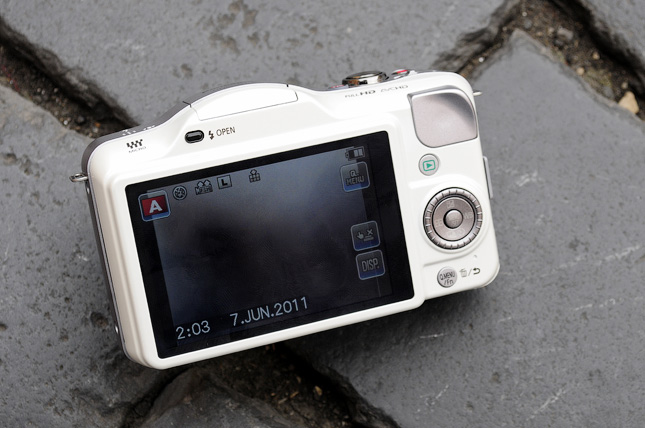
The display is resistive, its resolution is 460,000 points, and the diagonal is three inches. I did not feel any discomfort when sighting and viewing photos, the grain is almost indistinguishable. But if you shoot in bright sunshine, the same problem manifests itself as with the GF2 - the LCD screen is very bright. It is necessary to close it from above with the palm of the left hand in order to see what exactly entered the frame.
Internal changes are almost as radical as external ones - GF3 has been thoroughly pumped. The new Venus Engine VII HD processor was installed in the camera and the autofocus system was improved. In a press release, Panasonic cites data from its own measurements of the GF3 autofocus speed in conjunction with different lenses, and the average is about 0.2 seconds. And it seems to me that the manufacturer is not being cunning. Having photographed the day before on a Nikon D300s DSLR and then having walked around Rome with GF3 for three hours, I didn’t notice a significant difference in the autofocus speed. Before the “three-hundred” Panasonic mirrorless even had an advantage - focusing at a selected point in the frame by pressing the touchscreen display.
Internal changes influenced the rate of fire of the camera. GF3 is capable of shooting at 4 frames per second. I can not say how the new camera will behave in the twilight or darkness, but in bright daylight it makes it very easy to capture dynamic scenes. Before us, for example, burned roller burning Italian grandfather. With such a rate of fire it was quite easy to shoot it.
And, of course, the most important thing. In addition to the new processor, the GF3 also has a new Live MOS matrix with increased sensitivity. A small grain is noticeable in images at ISO400, but it will not have a significant impact on the quality of printing photos. Moreover, it can be easily removed with the help of software shumodava. At ISO800, the noise is more pronounced, but the photos are still suitable for printing in A4 format and, possibly, after processing even in A3. Substantial losses in detailing begin at ISO1600, but even such photos can be safely carried to the photo lab and asked to print in 20x15 format. For a camera that represents the youngest line of mirrorless mirrors, the indicators are quite good. Only one thing remained unclear - the minimum ISO value is 160 units. Sometimes there was not enough of the usual ISO100 for shooting landscapes in bright daylight.
 |  |
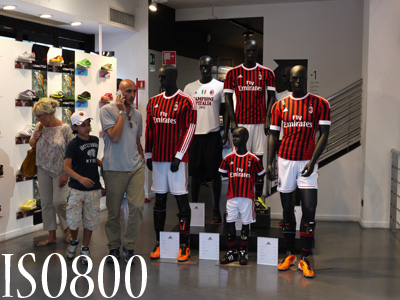 |  |
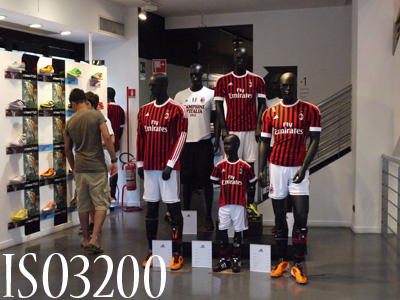 |  |
Another mysterious story is connected with the battery of the new camera. One of my colleagues had enough of him for 1200 photos. I shot about 300 frames and about 5 minutes of video, the battery at the same time was discharged by a third. Immediately I remembered the experience of the April shooting in Barcelona on the previous mirrorless of the same line - GF2. Then one full charge of a more capacious (if we compare the rate of mAh) battery was enough for me on average 400 frames. Whether this is some kind of magic, or the developers of Panasonic will soon invent a perpetual motion machine.
In addition, the Panasonic GF3 has outstanding video capabilities. The camera can record Full HD videos in 50i format or regular HD, but in progressive scan. The choice is still available two compression codec - AVCHD or Motion JPEG. And unlike DSLRs, there are no problems with autofocus. The result was not surprised, but pleasantly pleased. It is even a pity that there was no time for a thoughtful high-quality shooting with a tripod. Of the minuses, only the rolling shutter was seen, but this is an expected phenomenon.
Leica 25 / 1.4
Together with GF3, the Japanese presented another, no less interesting, novelty. This lens is a Micro Four Thirds Lieca Summilux system with a focal length of 25 mm and a aperture of 1.4.

Taking into account the Crop-factor of the system cameras Panasonic, equal to two units, we get the classic high-aperture "Cinar". The design of the lens includes 9 elements in 7 groups, including two aspherical and one with a high refractive index. The lens weighs about 200 grams. Of course, if this lens is attached to the GF3, then there can no longer be a special compactness of speech. But the picture quality is amazing! Actually, all the test photos and a test video were taken on the Panasonic Lumix GF3 and the new Leica lens.
 | 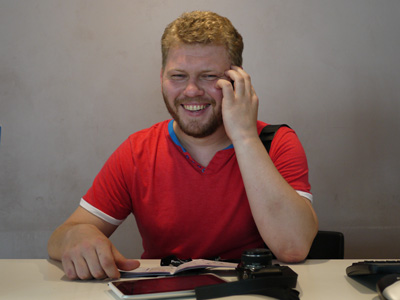 |
 |  |
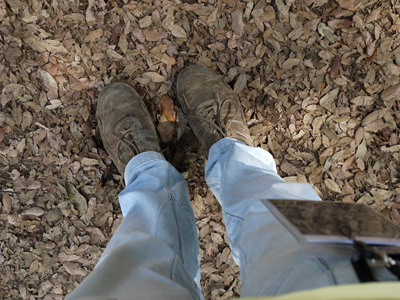 | 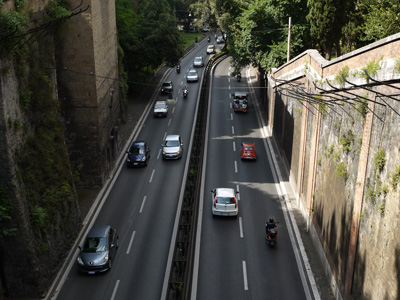 |
 | 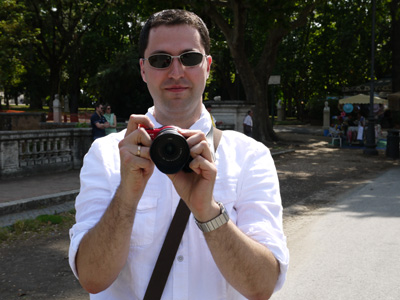 |
 |  |
 |  |
 | 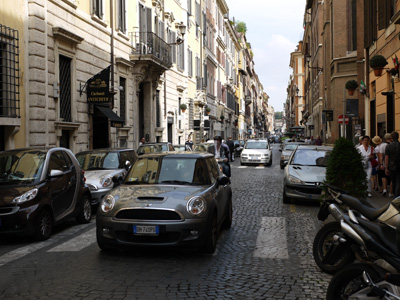 |
 |  |
Summary
Looking at the three new products from Panasonic, we can safely say that the Japanese are as serious as possible. After all, they didn’t just show so beautiful slides at the presentation that they conquer the mirrorless market, not in word, but in deed. Sales of system cameras compared to sales of SLR cameras in Japan (34% vs. 66%) speak for themselves. And what is popular in the land of the rising sun inevitably turns out to be popular with us.
Although, if we abstract from marketing games and percentages, the point is not even in popularity. The point in the ratio of "convenience - price - result." And if last year, the Nexes from Sony were in the lead by this ratio, now GF3 has all the chances to take a leading position for a long time. Against the background of the sluggish announcement of the NEX C3 with its very minor improvements, the Panasonic mirrorless looks much more interesting in all respects. Especially, if the price really will correspond to the projected: $ 700 for the GF3 in a set of 14 mm lens pancake or $ 600 for the "whale" with a standard zoom 14-42.
Source: https://habr.com/ru/post/121820/
All Articles